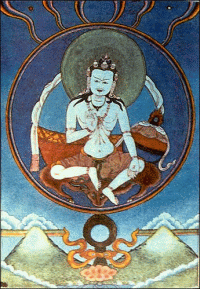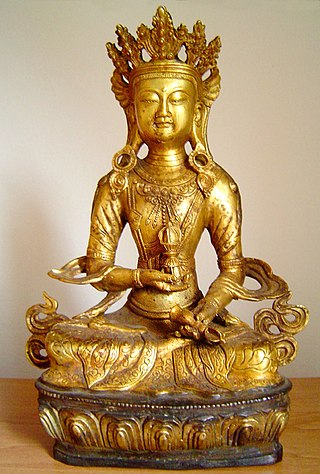
Longchen Rabjam Drimé Özer, commonly abbreviated to Longchenpa was a Tibetan scholar-yogi of the Nyingma school of Tibetan Buddhism. According to tibetologist David Germano, Longchenpa's work led to the dominance of the Longchen Nyingthig lineage of Dzogchen over the other Dzogchen traditions. He is also responsible for the scholastic systematization of Dzogchen thought within the context of the wider Tibetan Vajrayana tradition of philosophy which was highly developed at the time among the Sarma schools. Germano also notes that Longchenpa's work is "generally taken to be the definitive expression of the Great Perfection with its precise terminological distinctions, systematic scope, and integration with the normative Buddhist scholasticism that became dominant in Tibet during the thirteenth and fourteenth centuries."

Dzogchen, also known as atiyoga, is a tradition of teachings in Indo-Tibetan Buddhism and Yungdrung Bon aimed at discovering and continuing in the ultimate ground of existence. The primordial ground is said to have the qualities of purity, spontaneity and compassion. The goal of Dzogchen is knowledge of this basis, this knowledge is called rigpa. There are numerous spiritual practices taught in the various Dzogchen systems for awakening rigpa.

Nyingma, often referred to as Ngangyur, is the oldest of the four major schools of Tibetan Buddhism. The Nyingma school is founded on the first lineages and translations of Buddhist scriptures from Sanskrit into Tibetan in the eighth century, during the reign of King Trisong Detsen.
Longdé is the name of one of three scriptural divisions within Dzogchen, which is itself the pinnacle of the ninefold division of practice according to the Nyingma school of Tibetan Buddhism.

Garab Dorje was the first human to receive the complete direct transmission teachings of Sutra, Tantra and Dzogchen from Vajrasattva. The circumstances of his birth are shrouded in different interpretations, with some accounts describing a miraculous birth by a virgin daughter of the king of Uddiyana.
The Seven Treasuries, are a collection of seven works, some with auto-commentaries, by the Tibetan Buddhist teacher Longchenpa (1308–1364). They constitute his most influential scholarly output and together provide a systematic overview of exoteric and esoteric topics from the point of view of the Nyingma school's Dzogchen tradition.

Rigdzin Kumaradza (1266–1343) was a Dzogchen master in the lineage of the Vima Nyingthig.

Vajrasattva is a bodhisattva in the Mahayana, Mantrayana/Vajrayana Buddhist traditions. In Chinese Buddhism and the Japanese Shingon tradition, Vajrasattva is the esoteric aspect of the bodhisattva Samantabhadra and is commonly associated with the student practitioner who through the master's teachings, attains an ever-enriching subtle and rarefied grounding in their esoteric practice. In Tibetan Buddhism, Vajrasattva is associated with the sambhogakāya and purification practice.
Svabhava literally means "own-being" or "own-becoming". It is the intrinsic nature, essential nature or essence of beings.
Richard Barron is a Canadian translator who specializes in the writings of Longchenpa. He has served as an interpreter for many lamas from all four schools of Tibetan Buddhism, including his first teacher, Kalu Rinpoche. He completed a traditional three year retreat in 1980 at Kagyu Ling in France, and later became a close student of the late Chagdud Tulku Rinpoche. He is currently engaged in a long-term project to translate the Seven Treasuries of Longchenpa. He has been a Tsadra Foundation fellow since 2000.

Melong is a Tibetan term that means "mirror", "looking glass". The melong is a polyvalent symbol, divine attribute, and quality of the enlightened mindstream or bodhicitta.
Vima Nyingthig, "Seminal Heart of Vimalamitra", in Tibetan Buddhism is one of the two "seminal heart" collections of the menngagde cycle Dzogchen, the other one being "Seminal Heart of the Dakini". Traditionally the teachings are ascribed to Vimalamitra, but they were codified and collated by their Tibetan discoverers in the 11th and 12th century. The main discoverer of the Vima Nyingthig was Zhangtön Tashi Dorjé.

Ma Rinchen Chok, is numbered as one of the twenty-five principal disciples of Padmasambhava. Rinchen Chok was also a senior disciple of Vimalamitra. Rinchen Chok was an important lotsawa in the first wave of translations and was one of the first seven monks ever to be ordained in Tibet by Shantarakshita, known as the 'seven men who were tested'. The ordination lineage was Sarvastivadin.

The Seventeen Tantras of the Esoteric Instruction Series or the Seventeen Tantras of the Ancients are an important collection of tantras in the Nyingma school of Tibetan Buddhism. They comprise the core scriptures of the "esoteric instruction series" (Menngagde) of Dzogchen teachings and are its most authoritative scriptures.
The Reverberation of Sound Tantra, is considered to be the root tantra of the seventeen tantras of the Menngagde class of the Tibetan Buddhist Dzogchen tradition.
Nelug Dzö is a poetic vignette written in Classical Tibetan and one of the Seven Treasuries of Longchenpa. Longchenpa wrote Desum Nyingpo, a prose autocommentary to this work. Keith Dowman considers it a "magical psychotropic poem".
Self- Arising Primordial Awareness is one of the Seventeen tantras of Dzogchen Upadesha.
The Mirror of the Mind of Samantabhadra is one of the Seventeen tantras of Dzogchen Upadesha.

In Dzogchen, the ground or base is the primordial state. It is an essential component of the Dzogchen tradition for both the Bon tradition and the Nyingma school of Tibetan Buddhism. Knowledge of this ground is called rigpa.

The mind teachings of Tibet are a body of sacredly held instructions on the nature of mind and the practice of meditation on, or in accordance with, that nature. Although maintained and cultivated, to various degrees, within each of the major Tibetan Buddhist traditions, they are primarily associated with the mahamudra traditions of the Kagyu and the dzogchen traditions of the Nyingma.











